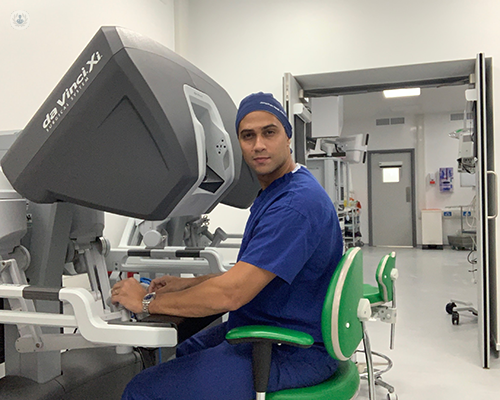What is robotic radical prostatectomy? All you need to know
Written in association with:Robotic radical prostatectomy is a state of the art minimally invasive surgical treatment option for prostate cancer. This surgical approach utilises cutting-edge computer technology that offers numerous benefits over traditional open or pure keyhole (laparoscopic) methods.
Mr Jonathan Noël, renowned consultant urological and robotic prostate surgeon, provides an expert insight.

When is robotic radical prostatectomy indicated?
Robotic radical prostatectomy is primarily indicated for patients diagnosed with localised or early-stage prostate cancer. This means that the cancer is confined to the prostate gland and has not spread to other parts of the body such as the bones or nodes outside the pelvis.
The other indication for the procedure is if a patient who is fit has prostate cancer that hasn’t responded to other cancer treatments, such as focal or radiation therapy.
How is robotic radical prostatectomy performed?
A robotic radical prostatectomy is a minimally invasive surgical procedure to remove the prostate gland and some of the surrounding tissue. The surgery is performed by docking a robotic system that enables the surgeon to perform this delicate operation with enhanced precision, dexterity, and control.
For the surgery, the patient is always given general anaesthesia, with the option of spinal anaesthetic additionally to ensure they are pain-free and comfortable during and immediately after the procedure. The surgeon begins the operation by making several small incisions (usually 6 with multiple port or 1-2 with the single port robot) in the abdomen to insert trocars (hollow tubes), of which the robotic system is mounted or docked to. The robotic system most commonly used worldwide is the Da Vinci surgical system. This is typically equipped with specialised instruments and a high-definition 3D camera. New robotic systems are currently on the market and are being utilised by a small number of surgeons as of 2024.
The robotic system docked to the trocars then allows the surgeon to sit at the console (shown above in the picture) to have complete control of the instruments to carefully dissect and remove the whole prostate gland. The precision has minimised blood loss and cancer margin control. When possible, the surgeon will aim to preserve the neurovascular bundles that control erectile function and continence, a process known as nerve-sparing prostatectomy.
Lastly, the bladder neck is reconstructed if needed, and realigned and sutured to the urethra. A urinary catheter is left in place for a few days to allow this delicate realignment to heal optimally by drainage, transporting the urine externally to a drainage bag. The skin incisions are closed with sutures and surgical glue.
How long does the surgery take?
The entire robotic radical prostatectomy procedure takes between 3 to 4 hours, depending on the anaesthetic time, complexity of the case, and the patient’s specific anatomy.
What is the typical recovery time after a robotic radical prostatectomy?
Recovery time following a robotic radical prostatectomy is much shorter compared to traditional open surgery. Most patients remain in the hospital for 1 to 2 days, and a catheter is typically needed for a 1-2 weeks to facilitate urine drainage while the bladder neck and urethra heal together.
Patients can often return to light activities within 2 to 4 weeks, with complete recovery (including a return to normal activities and work) at around 6 to 8 weeks’ time.
How does robotic radical prostatectomy improve patient outcomes in terms of cancer control, urinary continence, and sexual function?
Robotic radical prostatectomy offers significant benefits:
Cancer control
Robotic radical prostatectomy offers high success rates of cancer control, particularly for early-stage prostate cancer. The precision of the robotic system enables complete removal of cancerous tissue, thereby lowering the risk of cancer recurrence compared to other therapies.
Urinary continence
One of the significant benefits of robotic surgery is its ability to preserve urinary continence. The robotic system’s dexterity and vision allow sparing of pelvic floor muscle and their fasci, along with the peripheral apical structures that control urine storage. This leads to quicker and more complete recovery of urinary continence, which can be variable depending on the surgeon’s approach regarding the space of retzius.
Sexual function
The nerve-sparing techniques used in robotic prostatectomy play a crucial role in maintaining erectile function. While erectile dysfunction is possible after surgery, most patients will see improvements in erectile function within a year, especially when nerve-sparing techniques are successfully employed. Adjuncts such as minimising diathermy (heat), retrograde nerve release, and intraoperative computer vision of the tumour are contemporary methods to maximise nerve sparing.
Patients considering robotic radical prostatectomy should consult with a specialised urological and robotic prostate surgeon to determine if they are suitable candidates. They should discuss the potential benefits and risks specific to their condition. Understanding the intricacies of the procedure and its advantages can help patients make informed decisions about their prostate cancer treatment.
If you would like to book an appointment with Mr Jonathan Noël, head on over to his Top Doctors profile today.


